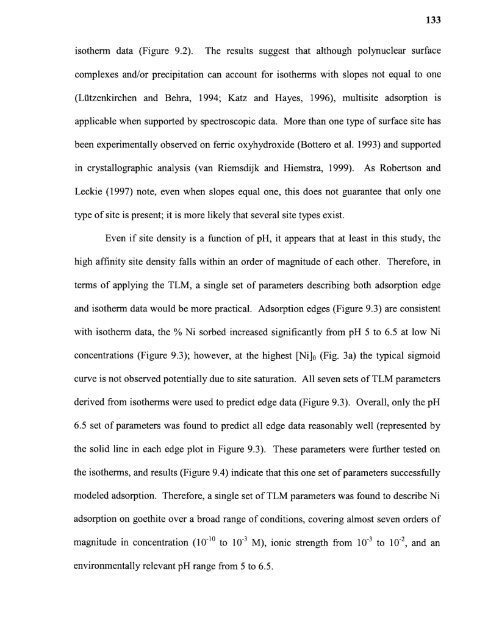Heavy metal adsorption on iron oxide and iron oxide-coated silica ...
Heavy metal adsorption on iron oxide and iron oxide-coated silica ...
Heavy metal adsorption on iron oxide and iron oxide-coated silica ...
You also want an ePaper? Increase the reach of your titles
YUMPU automatically turns print PDFs into web optimized ePapers that Google loves.
133isotherm data (Figure 9.2). The results suggest that although polynuclear surfacecomplexes <strong>and</strong>/or precipitati<strong>on</strong> can account for isotherms with slopes not equal to <strong>on</strong>e(Lützenkirchen <strong>and</strong> Behra, 1994; Katz <strong>and</strong> Hayes, 1996), multisite <str<strong>on</strong>g>adsorpti<strong>on</strong></str<strong>on</strong>g> isapplicable when supported by spectroscopic data. More than <strong>on</strong>e type of surface site hasbeen experimentally observed <strong>on</strong> ferric oxyhydr<strong>oxide</strong> (Bottero et al. 1993) <strong>and</strong> supportedin crystallographic analysis (van Riemsdijk <strong>and</strong> Hiemstra, 1999). As Roberts<strong>on</strong> <strong>and</strong>Leckie (1997) note, even when slopes equal <strong>on</strong>e, this does not guarantee that <strong>on</strong>ly <strong>on</strong>etype of site is present; it is more likely that several site types exist.Even if site density is a functi<strong>on</strong> of pH, it appears that at least in this study, thehigh affinity site density falls within an order of magnitude of each other. Therefore, interms of applying the TLM, a single set of parameters describing both <str<strong>on</strong>g>adsorpti<strong>on</strong></str<strong>on</strong>g> edge<strong>and</strong> isotherm data would be more practical. Adsorpti<strong>on</strong> edges (Figure 9.3) are c<strong>on</strong>sistentwith isotherm data, the % Ni sorbed increased significantly from pH 5 to 6.5 at low Nic<strong>on</strong>centrati<strong>on</strong>s (Figure 9.3); however, at the highest [Ni]0 (Fig. 3a) the typical sigmoidcurve is not observed potentially due to site saturati<strong>on</strong>. All seven sets of TLM parametersderived from isotherms were used to predict edge data (Figure 9.3). Overall, <strong>on</strong>ly the pH6.5 set of parameters was found to predict all edge data reas<strong>on</strong>ably well (represented bythe solid line in each edge plot in Figure 9.3). These parameters were further tested <strong>on</strong>the isotherms, <strong>and</strong> results (Figure 9.4) indicate that this <strong>on</strong>e set of parameters successfullymodeled <str<strong>on</strong>g>adsorpti<strong>on</strong></str<strong>on</strong>g>. Therefore, a single set of TLM parameters was found to describe Ni<str<strong>on</strong>g>adsorpti<strong>on</strong></str<strong>on</strong>g> <strong>on</strong> goethite over a broad range of c<strong>on</strong>diti<strong>on</strong>s, covering almost seven orders ofmagnitude in c<strong>on</strong>centrati<strong>on</strong> (10 -10 to 10-3 M), i<strong>on</strong>ic strength from 10 -3 to 10-2, <strong>and</strong> anenvir<strong>on</strong>mentally relevant pH range from 5 to 6.5.
















